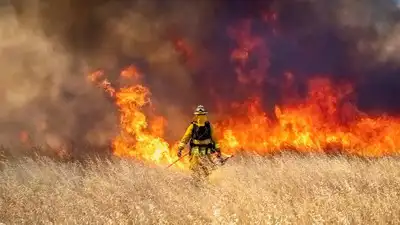Emergency declared in 2 US states! Wildfire smoke forces outdoor activity warnings nationwide

Emergency declared in 2 US states! Wildfire smoke forces outdoor activity warnings nationwide
A growing environmental emergency is unfolding across North America as massive wildfires raging in Canada send thick clouds of smoke across the border, triggering air-quality alerts across a dozen US states.
The smoke-laden skies are not just a visual disturbance—they're a serious public health hazard, especially for vulnerable populations including children, seniors, and individuals with preexisting respiratory or cardiovascular conditions. In the face of worsening climate patterns, the wildfire season—once a localized concern—is now a transboundary crisis, with significant health, environmental, and economic repercussions.As of early June 2025, more than 25,000 Canadians have been forced to evacuate their homes across provinces such as Saskatchewan, Alberta, and Manitoba, as per The Economic Times report. Simultaneously, millions of Americans are waking up under hazy skies with warnings from health agencies to avoid outdoor activities. What was once a seasonal concern has now become a persistent reminder of how climate change and ecosystem mismanagement can transcend borders—impacting air, health, and daily life far beyond the fire's origin.
As per reports, Canadian officials have described the current wildfire season as among the most destructive in recent history. At least 33,000 residents have been evacuated across three provinces: Saskatchewan, Alberta, and Manitoba. The fires—triggered by both human activity and lightning—have destroyed vast swaths of forested land and prompted large-scale emergency responses.
The smoke from these fires has traveled hundreds of miles southward into the United States, carried by jet streams and wind patterns that show no sign of relenting.
In response to the dangerous levels of fine particulate matter (PM2.5) in the air, the National Weather Service (NWS) and local authorities have issued air-quality alerts across at least 14 US states. These include:
These alerts classify the air quality as “Unhealthy for Sensitive Groups” to “Very Unhealthy” in some regions. The Air Quality Index (AQI), which typically ranges from “Good” to “Hazardous,” has spiked well beyond safe thresholds in multiple cities, prompting officials to recommend:
Health experts have sounded the alarm on the serious implications of prolonged exposure to wildfire smoke, especially PM2.5 particles, which can penetrate deep into the lungs and even enter the bloodstream.According to Professor Jonathan Grigg, a leading pediatric respiratory expert at Queen Mary University of London:“There are vulnerable groups, and classically they are children, because they've got an extra issue to do with their lungs developing… There are also very clear links between inhaling particles and earlier death from both respiratory and cardiovascular diseases.”Groups most at risk:
Doctors warn that symptoms such as coughing, sore throats, chest tightness, difficulty breathing, and fatigue can worsen rapidly in smoky conditions.
Long-term exposure could lead to chronic respiratory issues, especially in children.
Canada's wildfire season has grown longer, more intense, and less predictable, largely due to climate change. Rising temperatures and prolonged droughts have created ideal conditions for wildfires to ignite and spread quickly.Key factors contributing to this year’s fires:
According to climate scientists, this phenomenon is no longer seasonal.
The economic toll is immense, with cross-border costs—including disrupted flights, healthcare burdens, emergency response, and lost labor productivity—estimated to exceed $244 billion annually, as reported in environmental impact assessments.
Beyond immediate health precautions, officials are also urging the public to take environmentally responsible actions to reduce air pollution and slow climate-related wildfire escalation. Some common suggestions include:
In the short term, cities are distributing air quality forecasts and emergency alerts through apps, social media, and public signage. Longer-term strategies require stronger climate policies, land management reforms, and intergovernmental cooperation.











